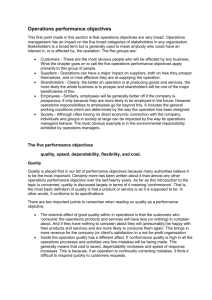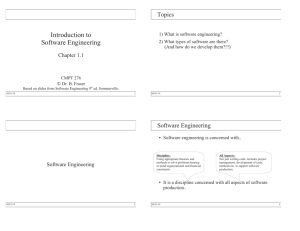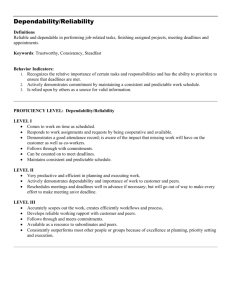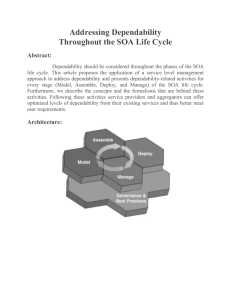Security and Dependability
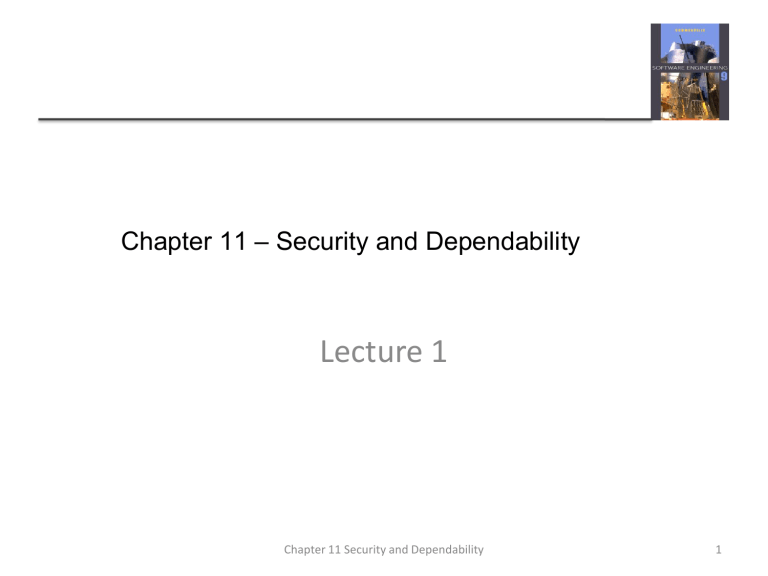
Chapter 11 – Security and Dependability
Lecture 1
Chapter 11 Security and Dependability 1
Topics covered
Dependability properties
The system attributes that lead to dependability.
Availability and reliability
Systems should be available to deliver service and perform as expected.
Safety
Systems should not behave in an unsafe way.
Security
Systems should protect themselves and their data from external interference.
System dependability
For many computer-based systems, the most important system property is the dependability of the system.
The dependability of a system reflects the user’s degree of trust in that system . It reflects the extent of the user’s confidence that it will operate as users expect and that it will not ‘fail’ in normal use.
Dependability covers the related systems attributes of reliability, availability and security. These are all interdependent.
Chapter 11 Security and Dependability 3
Importance of dependability
System failures may have widespread effects with large numbers of people affected by the failure.
Systems that are not dependable and are unreliable, unsafe or insecure may be rejected by their users.
The costs of system failure may be very high if the failure leads to economic losses or physical damage.
Undependable systems may cause information loss with a high consequent recovery cost.
Chapter 11 Security and Dependability 4
Causes of failure
Hardware failure
Hardware fails because of design and manufacturing errors or because components have reached the end of their natural life.
Software failure
Software fails due to errors in its specification, design or implementation.
Operational failure
Human operators make mistakes. Now perhaps the largest single cause of system failures in socio-technical systems.
Chapter 11 Security and Dependability 5
Principal dependability properties
Availability: The probability that the system will be up and running and able to deliver useful services to users.
Reliability: The probability that the system will correctly deliver services as expected by users.
Safety: A judgment of how likely it is that the system will cause damage to people or its environment.
Security: A judgment of how likely it is that the system can resist accidental or deliberate intrusions.
Chapter 11 Security and Dependability 6
Other dependability properties
Repairability
Reflects the extent to which the system can be repaired in the event of a failure
Maintainability
Reflects the extent to which the system can be adapted to new requirements;
Survivability
Reflects the extent to which the system can deliver services whilst under hostile attack;
Error tolerance
Reflects the extent to which user input errors can be avoided and tolerated.
Chapter 11 Security and Dependability 7
Dependability attribute dependencies
Safe system operation depends on the system being available and operating reliably.
A system may be unreliable because its data has been corrupted by an external attack.
Denial of service attacks on a system are intended to make it unavailable.
If a system is infected with a virus, you cannot be confident in its reliability or safety.
Chapter 11 Security and Dependability 8
Dependability achievement
Avoid the introduction of accidental errors when developing the system.
Design V & V processes that are effective in discovering residual errors in the system.
Design protection mechanisms that guard against external attacks.
Configure the system correctly for its operating environment.
Include recovery mechanisms to help restore normal system service after a failure.
Chapter 11 Security and Dependability 9
Dependability costs
Dependability costs tend to increase exponentially as increasing levels of dependability are required.
There are two reasons for this
The use of more expensive development techniques and hardware that are required to achieve the higher levels of dependability.
The increased testing and system validation that is required to convince the system client and regulators that the required levels of dependability have been achieved.
Chapter 11 Security and Dependability 10
Cost/dependability curve
Chapter 11 Security and Dependability 11
Availability and reliability
Reliability
The probability of failure-free system operation over a specified time in a given environment for a given purpose
Availability
The probability that a system, at a point in time, will be operational and able to deliver the requested services
Both of these attributes can be expressed quantitatively e.g. availability of 0.999 means that the system is up and running for 99.9% of the time.
Chapter 11 Security and Dependability 12
Availability and reliability
It is sometimes possible to subsume system availability under system reliability
Obviously if a system is unavailable it is not delivering the specified system services.
However, it is possible to have systems with low reliability that must be available.
So long as system failures can be repaired quickly and does not damage data, some system failures may not be a problem.
Availability is therefore best considered as a separate attribute reflecting whether or not the system can deliver its services.
Availability takes repair time into account, if the system has to be taken out of service to repair faults.
Chapter 11 Security and Dependability 13
Perceptions of reliability
The formal definition of reliability does not always reflect the user’s perception of a system’s reliability
The assumptions that are made about the environment where a system will be used may be incorrect
• Usage of a system in an office environment is likely to be quite different from usage of the same system in a university environment
The consequences of system failures affects the perception of reliability
• Unreliable windscreen wipers in a car may be irrelevant in a dry climate
• Failures that have serious consequences (such as an engine breakdown in a car) are given greater weight by users than failures that are inconvenient
Chapter 11 Security and Dependability 14
Reliability and specifications
Reliability can only be defined formally with respect to a system specification i.e. a failure is a deviation from a specification.
However, many specifications are incomplete or incorrect – hence, a system that conforms to its specification may ‘fail’ from the perspective of system users.
Furthermore, users don’t read specifications so don’t know how the system is supposed to behave.
Therefore perceived reliability is more important in practice.
Chapter 11 Security and Dependability 15
Availability perception
Availability is usually expressed as a percentage of the time that the system is available to deliver services e.g.
99.95%.
However, this does not take into account two factors:
The number of users affected by the service outage. Loss of service in the middle of the night is less important for many systems than loss of service during peak usage periods.
The length of the outage. The longer the outage, the more the disruption. Several short outages are less likely to be disruptive than 1 long outage. Long repair times are a particular problem.
Chapter 11 Security and Dependability 16
Reliability terminology
Term
Human error or mistake
System fault
System error
System failure
Description
Human behavior that results in the introduction of faults into a system.
For example, in the wilderness weather system, a programmer might decide that the way to compute the time for the next transmission is to add 1 hour to the current time. This works except when the transmission time is between 23.00 and midnight (midnight is 00.00 in the 24-hour clock).
A characteristic of a software system that can lead to a system error.
The fault is the inclusion of the code to add 1 hour to the time of the last transmission, without a check if the time is greater than or equal to
23.00.
An erroneous system state that can lead to system behavior that is unexpected by system users. The value of transmission time is set incorrectly (to 24.XX rather than 00.XX) when the faulty code is executed.
An event that occurs at some point in time when the system does not deliver a service as expected by its users. No weather data is transmitted because the time is invalid.
Chapter 11 Security and Dependability 17
Faults and failures
Failures are a usually a result of system errors that are derived from faults in the system
However, faults do not necessarily result in system errors
The erroneous system state resulting from the fault may be transient and ‘corrected’ before an error arises.
The faulty code may never be executed.
Errors do not necessarily lead to system failures
The error can be corrected by built-in error detection and recovery
The failure can be protected against by built-in protection facilities. These may, for example, protect system resources from system errors
Chapter 11 Security and Dependability 18
A system as an input/output mapping
Chapter 11 Security and Dependability 19
Software usage patterns
Chapter 11 Security and Dependability 20
Reliability in use
Removing X% of the faults in a system will not necessarily improve the reliability by X%. A study at IBM showed that removing 60% of product defects resulted in a 3% improvement in reliability.
Program defects may be in rarely executed sections of the code so may never be encountered by users.
Removing these does not affect the perceived reliability.
Users adapt their behaviour to avoid system features that may fail for them.
A program with known faults may therefore still be perceived as reliable by its users.
Chapter 11 Security and Dependability 21
Reliability achievement
Fault avoidance
Development technique are used that either minimise the possibility of mistakes or trap mistakes before they result in the introduction of system faults.
Fault detection and removal
Verification and validation techniques that increase the probability of detecting and correcting errors before the system goes into service are used.
Fault tolerance
Run-time techniques are used to ensure that system faults do not result in system errors and/or that system errors do not lead to system failures.
Chapter 11 Security and Dependability 22
Safety
Safety is a property of a system that reflects the system’s ability to operate, normally or abnormally, without danger of causing human injury or death and without damage to the system’s environment.
It is important to consider software safety as most devices whose failure is critical now incorporate software-based control systems.
Safety requirements are often exclusive requirements i.e. they exclude undesirable situations rather than specify required system services. These generate functional safety requirements.
Chapter 11 Security and Dependability 23
Safety criticality
Primary safety-critical systems
Embedded software systems whose failure can cause the associated hardware to fail and directly threaten people. Example is the insulin pump control system.
Secondary safety-critical systems
Systems whose failure results in faults in other (socio-technical) systems, which can then have safety consequences. For example, the MHC-PMS is safety-critical as failure may lead to inappropriate treatment being prescribed.
Chapter 11 Security and Dependability 24
Safety and reliability
Safety and reliability are related but distinct
In general, reliability and availability are necessary but not sufficient conditions for system safety
Reliability is concerned with conformance to a given specification and delivery of service
Safety is concerned with ensuring system cannot cause damage irrespective of whether or not it conforms to its specification
Chapter 11 Security and Dependability 25
Unsafe reliable systems
There may be dormant faults in a system that are undetected for many years and only rarely arise.
Specification errors
If the system specification is incorrect then the system can behave as specified but still cause an accident.
Hardware failures generating spurious inputs
Hard to anticipate in the specification.
Context-sensitive commands i.e. issuing the right command at the wrong time
Often the result of operator error.
Chapter 11 Security and Dependability 26
Safety achievement
Hazard avoidance
The system is designed so that some classes of hazard simply cannot arise.
Hazard detection and removal
The system is designed so that hazards are detected and removed before they result in an accident.
Damage limitation
The system includes protection features that minimise the damage that may result from an accident.
Chapter 11 Security and Dependability 27
Normal accidents
Almost all accidents are a result of combinations of malfunctions rather than single failures.
It is probably the case that anticipating all problem combinations, especially, in software controlled systems is impossible so achieving complete safety is impossible.
Accidents are inevitable.
Chapter 11 Security and Dependability 28
Software safety benefits
Although software failures can be safety-critical, the use of software control systems contributes to increased system safety
Software monitoring and control allows a wider range of conditions to be monitored and controlled than is possible using electro-mechanical safety systems.
Software control allows safety strategies to be adopted that reduce the amount of time people spend in hazardous environments.
Software can detect and correct safety-critical operator errors.
Chapter 11 Security and Dependability 29
Security
The security of a system is a system property that reflects the system’s ability to protect itself from accidental or deliberate external attack.
Security is essential as most systems are networked so that external access to the system through the Internet is possible.
Security is an essential pre-requisite for availability, reliability and safety.
Chapter 11 Security and Dependability 30
Fundamental security
If a system is a networked system and is insecure then statements about its reliability and its safety are unreliable.
These statements depend on the executing system and the developed system being the same. However, intrusion can change the executing system and/or its data.
Therefore, the reliability and safety assurance is no longer valid.
Chapter 11 Security and Dependability 31
Security terminology
Term
Asset
Exposure
Vulnerability
Attack
Threats
Control
Definition
Something of value which has to be protected. The asset may be the software system itself or data used by that system.
Possible loss or harm to a computing system. This can be loss or damage to data, or can be a loss of time and effort if recovery is necessary after a security breach.
A weakness in a computer-based system that may be exploited to cause loss or harm.
An exploitation of a system’s vulnerability. Generally, this is from outside the system and is a deliberate attempt to cause some damage.
Circumstances that have potential to cause loss or harm. You can think of these as a system vulnerability that is subjected to an attack.
A protective measure that reduces a system’s vulnerability. Encryption is an example of a control that reduces a vulnerability of a weak access control system
Chapter 11 Security and Dependability 32
Examples of security terminology (MHC-PMS)
Term
Asset
Example
The records of each patient that is receiving or has received treatment.
Exposure Potential financial loss from future patients who do not seek treatment because they do not trust the clinic to maintain their data. Financial loss from legal action by the sports star. Loss of reputation.
Vulnerability A weak password system which makes it easy for users to set guessable passwords. User ids that are the same as names.
Attack An impersonation of an authorized user.
Threat
Control
An unauthorized user will gain access to the system by guessing the credentials (login name and password) of an authorized user.
A password checking system that disallows user passwords that are proper names or words that are normally included in a dictionary.
Chapter 11 Security and Dependability 33
Threat classes
Threats to the confidentiality of the system and its data
Can disclose information to people or programs that do not have authorization to access that information.
Threats to the integrity of the system and its data
Can damage or corrupt the software or its data.
Threats to the availability of the system and its data
Can restrict access to the system and data for authorized users.
Chapter 11 Security and Dependability 34
Damage from insecurity
Denial of service
The system is forced into a state where normal services are unavailable or where service provision is significantly degraded
Corruption of programs or data
The programs or data in the system may be modified in an unauthorised way
Disclosure of confidential information
Information that is managed by the system may be exposed to people who are not authorised to read or use that information
Chapter 11 Security and Dependability 35
Security assurance
Vulnerability avoidance
The system is designed so that vulnerabilities do not occur. For example, if there is no external network connection then external attack is impossible
Attack detection and elimination
The system is designed so that attacks on vulnerabilities are detected and neutralised before they result in an exposure. For example, virus checkers find and remove viruses before they infect a system
Exposure limitation and recovery
The system is designed so that the adverse consequences of a successful attack are minimised. For example, a backup policy allows damaged information to be restored
Chapter 11 Security and Dependability 36
Key points
The dependability in a system reflects the user’s trust in that system.
Dependability is a term used to describe a set of related
‘non-functional’ system attributes – availability, reliability, safety and security.
The availability of a system is the probability that it will be available to deliver services when requested.
The reliability of a system is the probability that system services will be delivered as specified.
Chapter 11 Security and Dependability 37
Key points
Reliability is related to the probability of an error occurring in operational use. A system with known faults may be reliable.
Safety is a system attribute that reflects the system’s ability to operate without threatening people or the environment.
Security is a system attribute that reflects the system’s ability to protect itself from external attack.
Dependability is compromised if a system is insecure as the code or data may be corrupted.
Chapter 11 Security and Dependability 38



